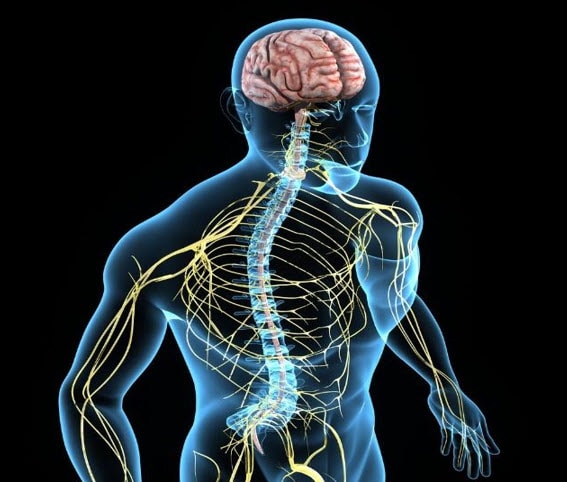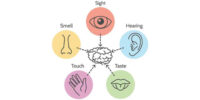Nervous System Components And Nerve Signaling

The nervous system is a complex network of cells, tissues, and organs that work together to control and coordinate the functions of the body. It is responsible for receiving and processing information from both internal and external stimuli and responding accordingly. Understanding the nervous system components and nerve signaling is essential for comprehending the mechanisms that govern human behavior, sensation, and movement.
The nervous system is divided into two main components: the Central Nervous System (CNS) and the Peripheral Nervous System (PNS). The CNS consists of the brain and spinal cord, which are responsible for processing and coordinating incoming sensory information, initiating motor responses, and integrating higher cognitive functions such as learning and memory.
The PNS, on the other hand, is composed of all the nerves and ganglia outside of the CNS, which serve to transmit information between the CNS and the rest of the body. Together, these two components work together to regulate the functions of the body and ensure its survival.
Key Takeaways
- The nervous system is responsible for controlling and coordinating body functions through the processing of information from stimuli.
- The nervous system is divided into the central nervous system (CNS) and peripheral nervous system (PNS), with the CNS consisting of the brain and spinal cord and the PNS consisting of nerves and ganglia outside of the CNS.
- Neurons transmit electrical and chemical signals through synapses and neurotransmitters, with the CNS processing sensory information and initiating motor responses while the PNS transmits information between the CNS and the rest of the body.
- Understanding nerve signaling processes is crucial for comprehending nervous system function, developing effective treatment plans for physical and cognitive symptoms, and contributing to overall health and well-being.
The Central Nervous System (CNS)
The Central Nervous System (CNS), consisting of the brain and spinal cord, plays a crucial role in receiving, processing, and transmitting sensory information throughout the body.
The brain serves as the central command center, receiving information from various sensory organs and processing it to generate appropriate responses.
The spinal cord acts as a relay station, transmitting signals between the brain and the rest of the body and coordinating reflex movements.
The brain and spinal cord are composed of specialized cells called neurons, which are responsible for transmitting electrical and chemical signals between different parts of the nervous system.
Neurons communicate with each other through specialized connections called synapses, where chemical messengers called neurotransmitters are released to transmit information.
The CNS is also supported by a network of glial cells, which provide structural support, regulate the chemical environment around neurons, and help to repair damage.
Together, the neurons and glial cells form a complex network that enables the CNS to perform a wide range of functions, from regulating breathing and heart rate to processing complex thoughts and emotions.
The Peripheral Nervous System (PNS)
One of the major subcategories of the nervous system responsible for connecting the central nervous system to the rest of the body’s organs and tissues is the Peripheral Nervous System (PNS). It is made up of nerves that extend from the brain and spinal cord, and it has two main components: the somatic nervous system and the autonomic nervous system.
The somatic nervous system is responsible for voluntary movements and sensory information, while the autonomic nervous system regulates involuntary functions such as heart rate, digestion, and breathing. The autonomic nervous system is further divided into the sympathetic and parasympathetic systems, which work together to maintain homeostasis in the body.
The PNS is essential for allowing the body to react to stimuli and maintain proper functioning, making it a crucial component of the overall nervous system.
Neurons: The Building Blocks of the Nervous System
Neurons are fascinating cells that play a fundamental role in transmitting information and processing signals in the human body. These complex cells are responsible for receiving signals from various stimuli and converting them into electrical impulses which are then transmitted through the body’s nervous system.
Neurons are made up of three main parts: the cell body, the dendrites, and the axon. The cell body contains the nucleus and other organelles that are responsible for maintaining the cell’s health and functions. Dendrites are the branching extensions of the cell body that receive signals from other neurons or sensory cells. The axon is a long, thin extension of the cell body that transmits signals to other neurons or muscles.
Neurons communicate with each other through a process called neurotransmission, where neurotransmitters are released from the axon terminal of one neuron and bind to receptors on another neuron’s dendrites.
Understanding the intricacies of neuronal communication is crucial for understanding the nervous system’s functions and how it controls the body’s processes.
Neurons are the building blocks of the nervous system and are responsible for transmitting information and processing signals. These complex cells are made up of three main parts: the cell body, dendrites, and axon. Neurons communicate with each other through neurotransmission, and understanding this process is crucial for understanding the nervous system’s functions.
Action Potentials: The Language of Neurons
Action potentials are the result of a coordinated series of events that involve the movement of ions across the neuronal membrane. When a neuron is at rest, there is a higher concentration of positively charged ions outside of the cell and a higher concentration of negatively charged ions inside the cell. This creates an electrical potential difference across the membrane, known as the resting potential.
However, when a stimulus is strong enough to depolarize the membrane, sodium ions rush into the cell, causing a rapid change in the membrane potential. This depolarization triggers the opening of voltage-gated ion channels, which allow even more sodium ions to enter the cell.
The influx of positively charged ions inside the cell causes a reversal in the membrane potential, known as the action potential. This process is followed by the repolarization phase, where the potassium ions leave the cell, restoring the membrane potential to its resting state.
The final phase is the hyperpolarization phase, where the membrane potential briefly becomes more negative than the resting potential, before returning to its resting state.
Synaptic Transmission: How Neurons Communicate
Synaptic transmission is a complex process involving the release and binding of neurotransmitters at the synapse. When an action potential reaches the axon terminal, it triggers the opening of voltage-gated calcium channels. The influx of calcium ions causes the synaptic vesicles to fuse with the presynaptic membrane, releasing neurotransmitters into the synaptic cleft.
These neurotransmitters then bind to specific receptors on the postsynaptic membrane, causing changes in ion channel permeability and ultimately leading to depolarization or hyperpolarization of the postsynaptic neuron.
The strength of the synaptic transmission can be modulated by various factors, including the amount of neurotransmitter released, the number and sensitivity of postsynaptic receptors, and the efficiency of neurotransmitter removal from the synaptic cleft. Additionally, different types of synapses can exhibit different properties, such as the speed and reliability of transmission.
Overall, synaptic transmission plays a crucial role in shaping neural signaling and information processing in the nervous system.
Neurotransmitters: Chemical Messengers of the Nervous System
Chemical messengers known as neurotransmitters play a critical role in transmitting signals between neurons and modulating neural activity. Neurotransmitters are synthesized within neurons and stored in synaptic vesicles at the presynaptic terminal.
When an action potential arrives at the presynaptic terminal, it triggers the release of neurotransmitters into the synaptic cleft, where they diffuse and bind to receptors on the postsynaptic neuron. This binding can either excite or inhibit the postsynaptic neuron, depending on the type of neurotransmitter and the type of receptor it binds to.
There are several different types of neurotransmitters, each with its own unique effects on neural activity. Some of the major neurotransmitters include:
- Acetylcholine: Involved in muscle movement, attention, learning, and memory.
- Dopamine: Involved in reward, motivation, and motor control.
- Serotonin: Involved in mood, appetite, and sleep.
Understanding the different types of neurotransmitters and their effects on neural activity is crucial for understanding the complex workings of the nervous system. Dysfunction in neurotransmitter systems has been implicated in a wide range of neurological and psychiatric disorders, including Parkinson’s disease, depression, and schizophrenia.
Nerve Signaling in Action: Examples of Nervous System Function
Neurotransmitters are essential chemical messengers that facilitate nerve signaling in the nervous system. They play a crucial role in transmitting signals from one nerve cell to another, ultimately leading to the execution of specific functions in the body. However, understanding the role of neurotransmitters alone is not sufficient to comprehend the complexity of the nervous system’s functioning.
Hence, in this section, we will explore various examples of nerve signaling in action and how they contribute to the overall functioning of the nervous system. One of the most fundamental examples of nerve signaling is the reflex arc. It is a rapid and involuntary response to a stimulus that occurs without conscious thought. For instance, when you accidentally touch a hot stove, your body responds immediately by withdrawing your hand from the heat source. This reflexive response occurs due to the involvement of sensory neurons that detect the stimulus, interneurons that process the information, and motor neurons that initiate the appropriate response.
Another example of nerve signaling is the transmission of signals in the autonomic nervous system, which controls involuntary actions such as heart rate, breathing, and digestion. This system comprises two branches- the sympathetic and parasympathetic nervous systems- that work in opposition to regulate bodily functions based on the body’s needs. Understanding nerve signaling in action is crucial to comprehend the functioning of the nervous system.
The reflex arc and autonomic nervous system are just a few examples of the complex interactions that occur within the nervous system. By studying these processes, we can gain a deeper understanding of how the nervous system works and how it contributes to our overall health and well-being.
Disorders of the Nervous System: Understanding and Treating Dysfunction
Dysfunction in the nervous system can manifest in various disorders, and understanding these conditions is crucial for their effective treatment.
One of the most common nervous system disorders is Alzheimer’s disease, a progressive condition that affects memory, thinking, and behavior. It is caused by the buildup of abnormal proteins in the brain, which leads to the death of brain cells.
Although there is currently no cure for Alzheimer’s disease, medications and lifestyle changes can help manage symptoms and slow the progression of the disease.
Another example of a nervous system disorder is Parkinson’s disease, which affects movement and coordination. It is caused by the death of dopamine-producing cells in the brain, and symptoms often include tremors, stiffness, and difficulty with balance.
While there is no cure for Parkinson’s disease, medications and deep brain stimulation can help manage symptoms and improve quality of life.
By understanding the underlying causes of these nervous system disorders, healthcare professionals can develop effective treatment plans that address both physical and cognitive symptoms, providing patients with the best possible care.
Conclusion
In conclusion, the nervous system is a complex network of components that work together to enable communication and coordination throughout the body.
The central nervous system, consisting of the brain and spinal cord, serves as the control center for the body, while the peripheral nervous system connects the CNS to the rest of the body.
Neurons, the building blocks of the nervous system, communicate through action potentials and synaptic transmission, facilitated by neurotransmitters.
Nerve signaling plays a crucial role in various functions of the body, including movement, sensation, and cognition. However, dysfunction in the nervous system can result in various disorders, such as Parkinson’s disease, multiple sclerosis, and Alzheimer’s disease.
Understanding the components and processes involved in nerve signaling is essential in developing effective treatments for these disorders. Overall, the nervous system is a remarkable system that enables the body to function and respond to the environment.








